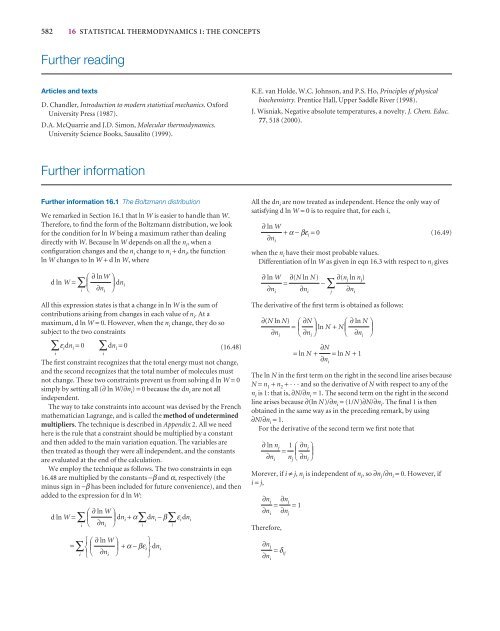Statistical thermodynamics 1: the concepts - W.H. Freeman
Statistical thermodynamics 1: the concepts - W.H. Freeman
Statistical thermodynamics 1: the concepts - W.H. Freeman
You also want an ePaper? Increase the reach of your titles
YUMPU automatically turns print PDFs into web optimized ePapers that Google loves.
PC8eC16 1/26/06 14:34 Page 582<br />
582 16 STATISTICAL THERMODYNAMICS 1: THE CONCEPTS<br />
Fur<strong>the</strong>r reading<br />
Articles and texts<br />
D. Chandler, Introduction to modern statistical mechanics. Oxford<br />
University Press (1987).<br />
D.A. McQuarrie and J.D. Simon, Molecular <strong><strong>the</strong>rmodynamics</strong>.<br />
University Science Books, Sausalito (1999).<br />
K.E. van Holde, W.C. Johnson, and P.S. Ho, Principles of physical<br />
biochemistry. Prentice Hall, Upper Saddle River (1998).<br />
J. Wisniak, Negative absolute temperatures, a novelty. J. Chem. Educ.<br />
77, 518 (2000).<br />
Fur<strong>the</strong>r information<br />
Fur<strong>the</strong>r information 16.1 The Boltzmann distribution<br />
We remarked in Section 16.1 that ln W is easier to handle than W.<br />
Therefore, to find <strong>the</strong> form of <strong>the</strong> Boltzmann distribution, we look<br />
for <strong>the</strong> condition for ln W being a maximum ra<strong>the</strong>r than dealing<br />
directly with W. Because ln W depends on all <strong>the</strong> n i , when a<br />
configuration changes and <strong>the</strong> n i change to n i + dn i , <strong>the</strong> function<br />
ln W changes to ln W + d ln W, where<br />
d ln W =∑<br />
i<br />
A ∂ lnW D<br />
B E dn<br />
C F i<br />
∂n i<br />
All this expression states is that a change in ln W is <strong>the</strong> sum of<br />
contributions arising from changes in each value of n i . At a<br />
maximum, d ln W = 0. However, when <strong>the</strong> n i change, <strong>the</strong>y do so<br />
subject to <strong>the</strong> two constraints<br />
∑ε i dn i = 0<br />
i<br />
∑dn i = 0 (16.48)<br />
i<br />
The first constraint recognizes that <strong>the</strong> total energy must not change,<br />
and <strong>the</strong> second recognizes that <strong>the</strong> total number of molecules must<br />
not change. These two constraints prevent us from solving d ln W = 0<br />
simply by setting all (∂ ln W/∂n i ) = 0 because <strong>the</strong> dn i are not all<br />
independent.<br />
The way to take constraints into account was devised by <strong>the</strong> French<br />
ma<strong>the</strong>matician Lagrange, and is called <strong>the</strong> method of undetermined<br />
multipliers. The technique is described in Appendix 2. All we need<br />
here is <strong>the</strong> rule that a constraint should be multiplied by a constant<br />
and <strong>the</strong>n added to <strong>the</strong> main variation equation. The variables are<br />
<strong>the</strong>n treated as though <strong>the</strong>y were all independent, and <strong>the</strong> constants<br />
are evaluated at <strong>the</strong> end of <strong>the</strong> calculation.<br />
We employ <strong>the</strong> technique as follows. The two constraints in eqn<br />
16.48 are multiplied by <strong>the</strong> constants −β and α, respectively (<strong>the</strong><br />
minus sign in −β has been included for future convenience), and <strong>the</strong>n<br />
added to <strong>the</strong> expression for d ln W:<br />
d ln W = ∑<br />
i<br />
=∑<br />
i<br />
A<br />
B<br />
C<br />
∂ ln W D<br />
E<br />
∂n i<br />
F<br />
1 A ∂ ln W D<br />
2 B E<br />
3 C ∂n i<br />
F<br />
dn i + α∑<br />
i<br />
5<br />
+ α − βε i 6 dn i<br />
7<br />
dn i − β∑ε i dn i<br />
i<br />
All <strong>the</strong> dn i are now treated as independent. Hence <strong>the</strong> only way of<br />
satisfying d ln W = 0 is to require that, for each i,<br />
∂ ln W<br />
+ α − βε i = 0 (16.49)<br />
∂n i<br />
when <strong>the</strong> n i have <strong>the</strong>ir most probable values.<br />
Differentiation of ln W as given in eqn 16.3 with respect to n i gives<br />
∂ ln W ∂(N ln N) ∂(n<br />
= − ∑<br />
j ln n j )<br />
∂n i ∂n i j ∂n i<br />
The derivative of <strong>the</strong> first term is obtained as follows:<br />
∂(N ln N) A ∂N D A ∂ ln N D<br />
= B E ln N + N B EF<br />
∂n i<br />
C ∂n i<br />
F C ∂n i<br />
∂N<br />
= ln N + = ln N + 1<br />
∂n i<br />
The ln N in <strong>the</strong> first term on <strong>the</strong> right in <strong>the</strong> second line arises because<br />
N = n 1 + n 2 + · · · and so <strong>the</strong> derivative of N with respect to any of <strong>the</strong><br />
n i is 1: that is, ∂N/∂n i = 1. The second term on <strong>the</strong> right in <strong>the</strong> second<br />
line arises because ∂(ln N)/∂n i = (1/N)∂N/∂n i . The final 1 is <strong>the</strong>n<br />
obtained in <strong>the</strong> same way as in <strong>the</strong> preceding remark, by using<br />
∂N/∂n i = 1.<br />
For <strong>the</strong> derivative of <strong>the</strong> second term we first note that<br />
∂ ln n j 1 A ∂n j D<br />
= B EF<br />
∂n i n j<br />
C ∂n i<br />
Morever, if i ≠ j, n j is independent of n i , so ∂n j /∂n i = 0. However, if<br />
i = j,<br />
∂n j ∂n j<br />
= =1<br />
∂n i ∂n j<br />
Therefore,<br />
∂n j<br />
= δ ij<br />
∂n i

















